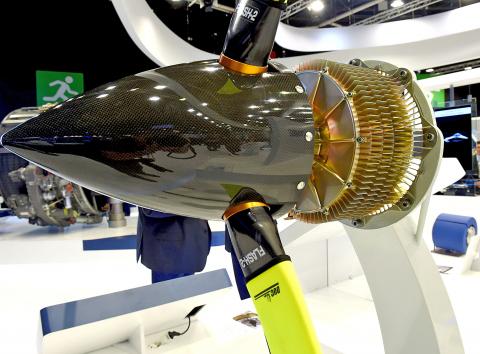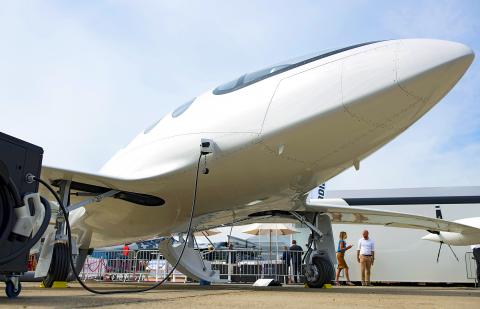An all-electric commuter plane and a small Airbus-backed hybrid are among aircraft programs being touted at the International Paris Air Show, as the industry tries to convince a skeptical public it can deliver on a pledge to halve carbon emissions by 2050.
Israeli start-up Eviation has wheeled out Alice, a battery-powered nine-seater due for its maiden flight later this year, while Airbus and suppliers Safran SA and Daher are showing a scale model of their planned EcoPulse, a similarly sized short-hopper that packs a fuel tank, as well as batteries.
The electric debuts come as European finance ministers are expected later this week to discuss ending aviation fuel tax exemptions to curb greenhouse emissions.

Photo: AFP
The spread of social media posts “flight-shaming” air travel has also jangled executives’ nerves and added pressure to electrify, following the auto industry’s lead.
However, unlike cars, electric planes must heft their power packs aloft — a reality that limits them to small aircraft on the shortest routes, as even their proponents concede.
“The impact of battery weight is an order of magnitude more severe for us,” said Stephane Cueille, Safran’s head of research, technology and innovation.

Photo: EPA-EFE
The EcoPulse’s engine drives a central propeller and a generator to recharge its batteries and power additional electric props spread along the wingspan, delivering 20 to 40 percent fuel savings on trips up to several hundred kilometers.
Whereas the French plane is still on the drawing board, Alice’s smooth contours can be seen on the tarmac at Le Bourget, north of Paris. Eviation is aiming for a first test-flight later this year and US certification by 2022.
On a single charge, Alice can fly 1,046km at 3048m with a cruising speed of 444kph.
Cape Air, a Massachusetts-based regional carrier, has taken an option to add a double-digit number of the US$4 million planes to its fleet, Eviation said at the show.
The aircraft, with a flattened profile and propellers at its wing tips, was designed as an electric plane from the ground up, Eviation founder and chief executive officer Omer Bar-Yohay said.
“It’s basically a huge battery with some plane painted on it,” he told reporters.
Among signs of growing interest from traditional players, engine maker Rolls-Royce Holdings PLC on Tuesday said it had bought the electric aerospace division of Germany’s Siemens AG — which is also one of the suppliers of motors to Alice.
Engineers see a bigger future for hybrids, which can combine lighter, downsized jet engines with an electric boost during take-off and climb, for a 30 percent fuel saving.
The additional thrusters or e-propellers also help stability, allowing a more streamlined airframe to reduce drag and consumption further.
“Then you’re starting to get to the kind of economics and sustainability that’s closer to a bus than it is to aviation historically,” United Technologies Corp chief technology officer Paul Eremenko said during a panel discussion.
UBS Group AG predicts demand for US$178 billion in green aviation technologies by 2040 as they become more mainstream.
“The consumer is probably going to demand an acceleration in this space,” said Celine Fornaro, the Swiss bank’s head of European industrials equity research. “It’s starting to be more present in everyone’s conscience.”
Airbus is also looking at hybrid-electric technology for future passenger aircraft generations, but few would bet on its readiness to power the 200-seaters expected to replace the workhorse A320 jet family in the 2030s.
Carbon emissions from commercial aviation account for about 2.5 percent of the global total, but are set to expand in step with emerging middle classes, especially in Asia.
To counter their effect, the industry is introducing the Carbon Offsetting and Reduction Scheme for International Aviation program, which requires airlines to fund cuts to atmospheric carbon dioxide elsewhere, offsetting their emissions growth, while awaiting hybrid planes and alternative fuels.
Reconciling airlines’ growth ambitions with their promised 50 percent carbon emissions cut from 2005 levels will be no easy task.
“We don’t know how that’s going to happen yet,” Boeing Co chief technology officer Greg Hyslop said.
Yet aerospace leaders are adamant that the answer cannot be fewer flights.
“We’ve got to make aviation grow and be sustainable,” Rolls-Royce chief technology officer Paul Stein said during the same panel. “Those who propose traveling less are heading for a darker place.”
Brussels-based lobby group Airlines for Europe said “taxing aviation is not a solution,” in a statement ahead of the EU ministerial meetings starting on Thursday in the Netherlands.
However, campaigners such as Greenpeace transport specialist Sarah Fayolle say taxation and other regulation is warranted by the urgent need to slash emissions.
“We’re facing a climate emergency that cannot wait for uncertain technological solutions that are decades away,” she said.

TAKING STOCK: A Taiwanese cookware firm in Vietnam urged customers to assess inventory or place orders early so shipments can reach the US while tariffs are paused Taiwanese businesses in Vietnam are exploring alternatives after the White House imposed a 46 percent import duty on Vietnamese goods, following US President Donald Trump’s announcement of “reciprocal” tariffs on the US’ trading partners. Lo Shih-liang (羅世良), chairman of Brico Industry Co (裕茂工業), a Taiwanese company that manufactures cast iron cookware and stove components in Vietnam, said that more than 40 percent of his business was tied to the US market, describing the constant US policy shifts as an emotional roller coaster. “I work during the day and stay up all night watching the news. I’ve been following US news until 3am

UNCERTAINTY: Innolux activated a stringent supply chain management mechanism, as it did during the COVID-19 pandemic, to ensure optimal inventory levels for customers Flat-panel display makers AUO Corp (友達) and Innolux Corp (群創) yesterday said that about 12 to 20 percent of their display business is at risk of potential US tariffs and that they would relocate production or shipment destinations to mitigate the levies’ effects. US tariffs would have a direct impact of US$200 million on AUO’s revenue, company chairman Paul Peng (彭雙浪) told reporters on the sidelines of the Touch Taiwan trade show in Taipei yesterday. That would make up about 12 percent of the company’s overall revenue. To cope with the tariff uncertainty, AUO plans to allocate its production to manufacturing facilities in

COLLABORATION: Given Taiwan’s key position in global supply chains, the US firm is discussing strategies with local partners and clients to deal with global uncertainties Advanced Micro Devices Inc (AMD) yesterday said it is meeting with local ecosystem partners, including Taiwan Semiconductor Manufacturing Co (TSMC, 台積電), to discuss strategies, including long-term manufacturing, to navigate uncertainties such as US tariffs, as Taiwan occupies an important position in global supply chains. AMD chief executive officer Lisa Su (蘇姿丰) told reporters that Taiwan is an important part of the chip designer’s ecosystem and she is discussing with partners and customers in Taiwan to forge strong collaborations on different areas during this critical period. AMD has just become the first artificial-intelligence (AI) server chip customer of TSMC to utilize its advanced

Six years ago, LVMH’s billionaire CEO Bernard Arnault and US President Donald Trump cut the blue ribbon on a factory in rural Texas that would make designer handbags for Louis Vuitton, one of the world’s best-known luxury brands. However, since the high-profile opening, the factory has faced a host of problems limiting production, 11 former Louis Vuitton employees said. The site has consistently ranked among the worst-performing for Louis Vuitton globally, “significantly” underperforming other facilities, said three former Louis Vuitton workers and a senior industry source, who cited internal rankings shared with staff. The plant’s problems — which have not